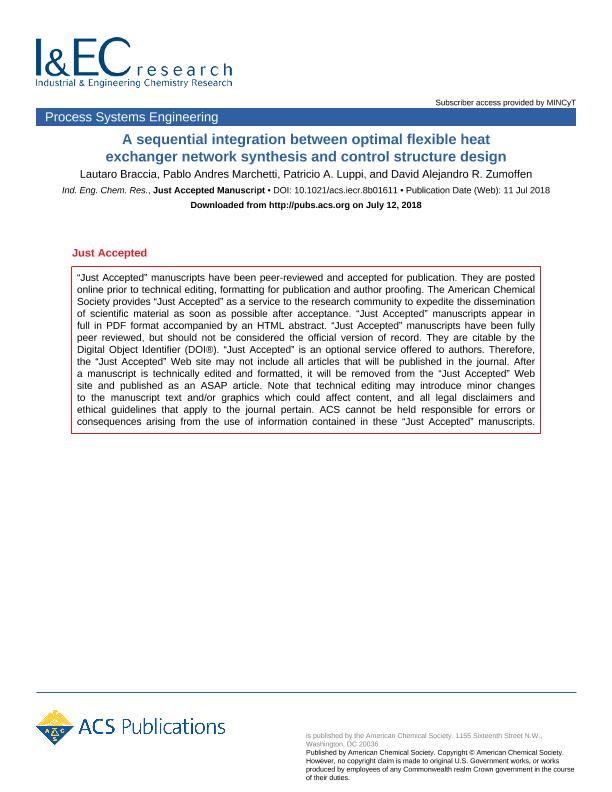Mostrar el registro sencillo del ítem
dc.contributor.author
Braccia, Lautaro

dc.contributor.author
Marchetti, Pablo Andres

dc.contributor.author
Luppi, Patricio Alfredo

dc.contributor.author
Zumoffen, David Alejandro Ramon

dc.date.available
2020-01-08T20:38:42Z
dc.date.issued
2018-08
dc.identifier.citation
Braccia, Lautaro; Marchetti, Pablo Andres; Luppi, Patricio Alfredo; Zumoffen, David Alejandro Ramon; A Sequential Integration between Optimal Flexible Heat Exchanger Network Synthesis and Control Structure Design; American Chemical Society; Industrial & Engineering Chemical Research; 57; 32; 8-2018; 11094-11111
dc.identifier.issn
0888-5885
dc.identifier.uri
http://hdl.handle.net/11336/94024
dc.description.abstract
In this work, the optimal synthesis and control structure design (CSD) problems for flexible heat exchanger networks (HENs) are integrated into a new sequential methodology. The proposed approach relies, on one hand, on a convexification and outer-approximation strategy to solve the synthesis stage and, on the other hand, on the sum of squared deviations (SSD) method for the optimal CSD. These methods guarantee the optimality of the synthesis process, as well as the proper operation of the HEN in several operating points. The first stage of the proposed approach, which focuses on the flexible HEN synthesis problem, considers both temperature and flow rate modifications in the inlet streams. A multiperiod synthesis formulation is proposed where critical points are iteratively incorporated to fulfill the flexibility requirements. Because the problem size and the nonconvexities increase when additional critical points are considered, both the convexification of nonlinear terms and an outer approximation strategy are used to guarantee the optimality of the solutions at this stage. The second stage handles the decisions associated with the design of the control structure. This stage is critical because the network is required to work in a wide range of operating points. If the classical CSD method based on the well-known relative gain array (RGA) is applied, and only the nominal operating point is considered, such requirements are not fullfiled. In fact, this work demonstrates that such classical CSD approaches are not sufficient to operate the HEN in the range of variation considered by the multiperiod synthesis phase. As an alternative method, the application of the SSD approach to multiple operating points is proposed. Thus, several optimal control structures are developed to ensure the operability of the HEN. Three academic case studies are presented to illustrate the application of the proposed methodology.
dc.format
application/pdf
dc.language.iso
eng
dc.publisher
American Chemical Society

dc.rights
info:eu-repo/semantics/openAccess
dc.rights.uri
https://creativecommons.org/licenses/by-nc-sa/2.5/ar/
dc.subject
PROCESS SYNTHESIS
dc.subject
HEAT EXCHANGE NETWORKS
dc.subject
MULTIVARIABLE CONTROL DESIGN
dc.subject
MIXED INTEGER QUADRATIC PROGRAMMING
dc.subject.classification
Control Automático y Robótica

dc.subject.classification
Ingeniería Eléctrica, Ingeniería Electrónica e Ingeniería de la Información

dc.subject.classification
INGENIERÍAS Y TECNOLOGÍAS

dc.title
A Sequential Integration between Optimal Flexible Heat Exchanger Network Synthesis and Control Structure Design
dc.type
info:eu-repo/semantics/article
dc.type
info:ar-repo/semantics/artículo
dc.type
info:eu-repo/semantics/publishedVersion
dc.date.updated
2019-10-17T14:57:00Z
dc.journal.volume
57
dc.journal.number
32
dc.journal.pagination
11094-11111
dc.journal.pais
Estados Unidos

dc.description.fil
Fil: Braccia, Lautaro. Universidad Nacional de Rosario; Argentina
dc.description.fil
Fil: Marchetti, Pablo A.. Universidad Nacional del Litoral; Argentina
dc.description.fil
Fil: Luppi, Patricio. Universidad Nacional de Rosario; Argentina
dc.description.fil
Fil: Zumoffen, David. Universidad Tecnológica Nacional; Argentina
dc.journal.title
Industrial & Engineering Chemical Research

dc.relation.alternativeid
info:eu-repo/semantics/altIdentifier/doi/http://dx.doi.org/10.1021/acs.iecr.8b01611
dc.relation.alternativeid
info:eu-repo/semantics/altIdentifier/url/https://pubs.acs.org/doi/10.1021/acs.iecr.8b01611
Archivos asociados
